‘Hacksaw Ridge’ Sound Mixer Kevin O’Connell On Producing A PTSD-Triggering Soundscape
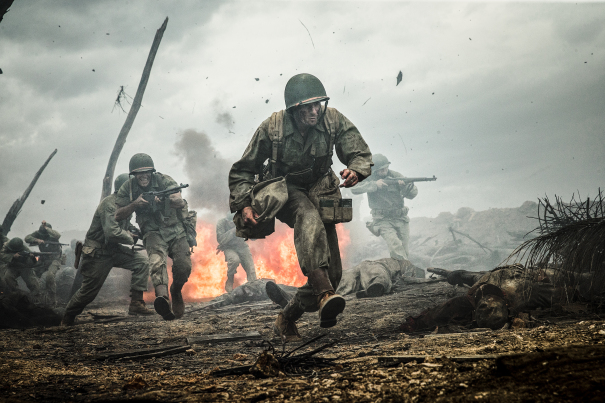
文章转载自:UniFi影视完片担保
No stranger to war films, re-recording mixer Kevin O’Connell re-teamed with frequent collaborator Mel Gibson on Hacksaw Ridge, starring Andrew Garfield, which tells the tale of one of the bloodiest battles in World War II, and the amazing man who saved over 70 lives but refused to wield a gun. As in the past, Gibson was an ideal collaborator for O’Connell, giving him and his team the space to work, while contributing uniquely in the clutch when necessary. Below, O’Connell breaks down the challenges of mixing sound for a low-budget war movie and the effect of the film’s sound on moviegoing veterans.
How did you come to work on Hacksaw Ridge?
Well, I’ve worked with Mel twice before that—the first time was on The Passion of The Christ, and the second time was on Apocalypto. I was approached by [producer] Bill Mechanic probably about eight or nine months before they started shooting the film, and they were going to have to post the entire film down in Australia due to the tax rebate. Mel was able to bring a couple of people down, and at that time, he was going to bring down [composer] James Horner and myself, and what happened was obviously James had an accident and died, and they called an audible on that. I was lucky enough to get the call to go down there and kind of help Mel wrangle that mix down there.
With this film, what were the broad strokes of the process in producing the sound mix?
Specifically on Hacksaw Ridge, if you take the battle scenes, for example, 90 percent of the production soundtrack for those battle scenes had been replaced. The only thing that remains from the original production track is some of the dialogue, and even much of the dialogue has been replaced, so basically it was a blank canvas when myself and the sound team started. Sound designer Rob Mackenzie and co-supervising sound editor Andy Wright, two fantastically talented Australian sound guys, together with this very astute editor by the name of Liam Price, carefully stitched together all of those battle sequences.

The production guns sound like cap guns, and the production explosion sounds like little fireworks going off, so what happens is, everything has to replaced. The idea was to replace them with period-specific weapons, so they could be period correct, and which the guys did, and did a really good job at. Sometimes for dramatic reasons, those things don’t always work out; for example, Vince Vaughn’s gun, in real life, that gun doesn’t sound it does in the movie. It sounds more like peashooter, so things have to be enhanced for dramatic purposes.
Basically, the first battle is about an eight or ten-minute battle with no music, so the sound team was tasked with having to choreograph that entire battle sequence with sound effects, which includes explosions, hand grenades, flame throwers, incoming missile sounds, a multitude of explosions. It’s one thing to play the on-camera stuff— that’s a given—but it’s the off-camera battle that became kind of the challenge, to keep the audience on the edge of their seat during the whole time of that off-stage battle, so that when we come back to the on-camera battle, it all makes sense.
What kind of technical set-up did you work with on the film, to create a sort of organized chaos with the sound?
Everything was sectioned off into food groups, in terms of the sound effects, the background, the foley, the weaponry. You had good guy guns distant, good guy guns close-up, bad guy guns distant, bad guy guns close-up.
As the perspective changed on the battlefield, so did the guns and the weaponry, so if we were hearing American guns on the left and the Japanese guns on the right, when we switched perspectives, those perspectives got switched, too. One of the things [the sound team] paid careful attention to was getting the sounds of the whizzing bullets in the air—we spent a lot of time panning those sounds in the overhead speakers and all around the theater.
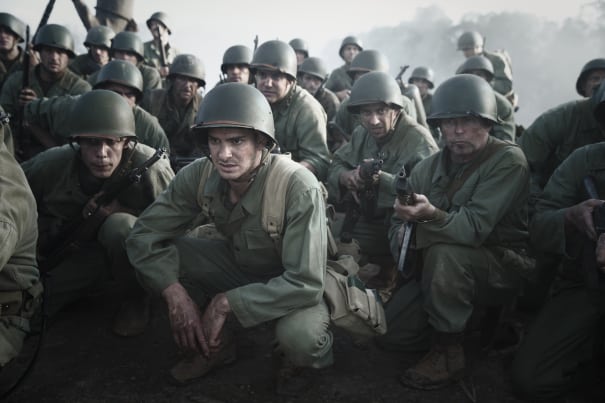
We had a screening here in Los Angeles for some veterans, and their one comment afterwards was that the sound of the whizzing and cracking bullets over their head was the one thing that sort of semi-triggered their PTSD a little bit. It wasn’t the graphic images, but the sound of the guns, and I know that Rob, Andy and Liam put a great effort into getting some actual archival sounds for that that were correct for the era.
What is it like for you, living within these horrifying battle sequences for months, and seeing them brought to life through sound?
The actors in the movie were performing at a ten; Mel Gibson directed this movie at a ten. The sound team felt that they had to step up, as well, and be as correct as possible—I mean as provocative as possible. What we’re seeing on screen is horrendous, the battle in the Pacific. That battle is one of the bloodiest ever in World War II, and Mel shot it that way, so the sound had to reinforce that image.
I know everyone works really hard to try to do that without overdoing it, because it’s easy to overdo it, and carpet bomb it with too much stuff. To be honest with you, they were choreographed so carefully, those battle scenes, that it was never hard for us, because it was challenging, but it was also gratifying because the image was so cool, that whenever we felt like we had attained the same level of cool with sound, it was actually a very gratifying experience for us.
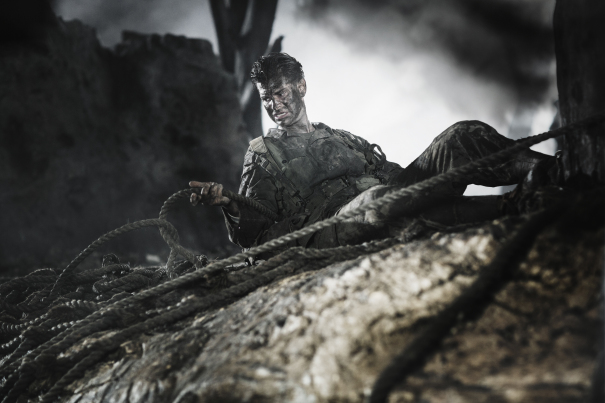
How was the experience working on this film, in comparison to other war films you’ve mixed, like Pearl Harbor?
Those films are never easy to do because it’s so easy to overdo them. You have to be so careful and so specific about the sounds, and what you’re hearing and when, depending on how you’re trying to tell the story through the use of sound.
This movie was in your face, visually, and so at times, the sound needed to step up and equal that in ways. Listen, these big war movies are always challenging because you’re playing 300 explosions, and they can’t all sound the same. You’ve got guns that have to sound differently, so the challenge is to mix it up and be diverse in the way that you’re playing sounds.
What were the biggest challenges with this production?
This movie wasn’t a very high budget movie—if this was a high budget war movie, we would have had a lot of money to go out and record guns to get all the correct, fresh recordings. But this was a very budget-challenged movie. The guys sourced every library that they could, that you could find online, because online now, you can find just about everything you want. They sourced material from all over the world to get the period-specific items they needed. Specifically the guns on the USS Missouri, the 16-inch naval cannon, they went long and hard to get those guns right.
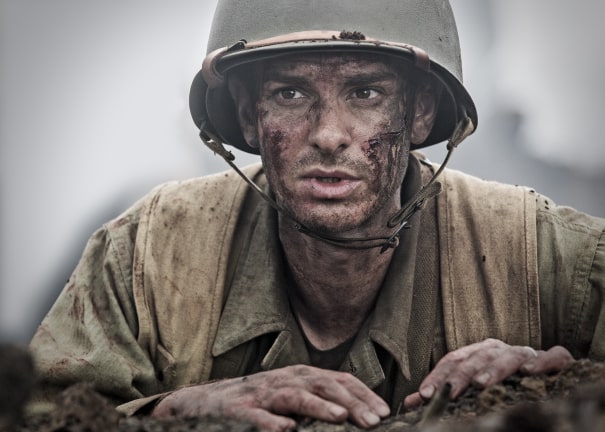
What is Mel Gibson like to work with, from your perspective?
It’s always exciting working with Mel Gibson, whether we’re crucifying Jesus and nailing him to a cross, or chopping off the heads of villagers and rolling them down the stairs of a Mayan temple. There’s never a dull moment when you’re working with Mel. He puts his heart and soul into everything he does. There’s this one moment [in the film] where Luke Bracey and Andrew Garfield are hunkering down in a foxhole after the first battle, and they’re surprised suddenly by a Japanese soldier, and we couldn’t find the exact right sound to shock the audience. Mel said, “Hey guys, can I give it a try?” We said sure, so we gave him a microphone, we played him the scene, and just as the Japanese soldier popped his head up, Mel screamed “Rargh!” into the microphone.
We took that sound and we placed it in all 56 speakers in the room, and the first time we played it, it scared the shit out of all of us, too, and that’s the kind of guy Mel is. He thinks outside the box, and he knew that he can make that scene work, and he used his own vocal range to make that happen. He’s a true artist by nature—he uses every single talent that he has, when he’s directing a movie, to get what he wants, and in this case, he knew that he could make the sound he wanted with his voice, so he did.
Another thing about Mel is he doesn’t micromanage. In the battle scenes in this movie, he let Rob, Andy, and myself put them together and then he would come in when we were down in Sydney, and just kind of review with us, and as many times as we played him the battle, he never gave it any notes other than, “It sounds great guys.” He was just very complimentary of the work that the sound team had done. He tends to look at scenes more emotionally, and decides what he wants to deride out of that scene emotionally, so the scene where maybe the guys are flame throwing, the sound of that flamethrower is exciting and cool for like the first two seconds, we hear it, but then after a while, he directed, “Hey guys, the focus isn’t on the flamethrower anymore. Let’s pull that down and let’s hear the guys that are getting torched a little bit, because that’s where the emotion of the scene is going.” He knows how to pull us in and out of whatever emotion he’s trying to evoke to the audience.
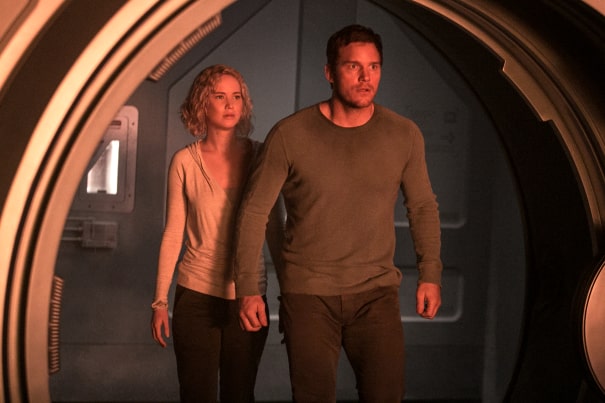
What’s the next project for you? I believe you’re currently finishing the mix on Passengers.
I’m actually in the middle of that right now. Passengers is a wonderful film. It’s a sci-fi love story aboard a spacecraft. I feel very fortunate that I’m working with this incredible sound designer by the name of Will Files, who crafted the voice and the character of this spaceship to bring it to life, because obviously this film relies heavily on visual effects. Will Files and his team did an amazing job of crafting a character and a voice for this ship.
Morten Tyldum is an amazing director to work with—he’s a very emotional director. Maryann Brandon, the picture editor, is amazing to work with. She’s just right on top of her game, and it’s just been an amazing project to be a part of.
